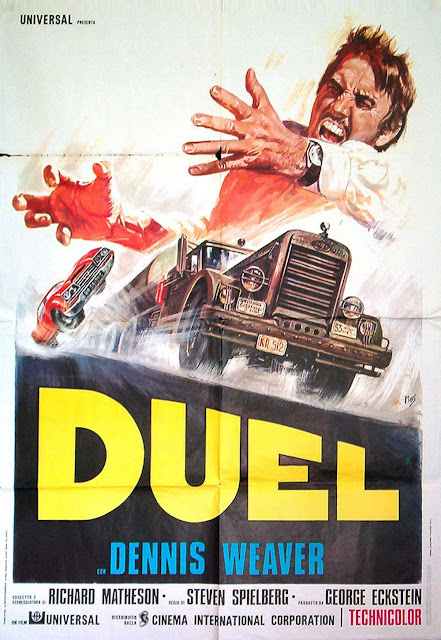 |
| Fig. 1 Poster |
Steven
Spielberg’s ‘Duel’ (1971) was his first film and was originally made as a
television film before being marked for theatrical release. The film follows
David Mann as he is harassed by a truck on a long journey. That is the basis of
the film and although the plot is thin, Spielberg works hard to make up for
this, and even make use of it, to create a thrilling film. Ian Freer writes for
Empire Online that ‘Tension and terror, not characterisation and plot, are what matter here.’
(Freer, 2000).
 |
| Fig. 2 Wide Shot |
 |
| Fig. 3 Low Angle: Mann |
 |
| Fig. 4 Close-up |
Freer
comments that ‘The
compositions are amazingly dynamic and diverse’ (Freer, 2000).
Spielberg uses wide shots to create a sense of isolation and distance, Fig. 2 shows one such shot. By placing Mann’s vehicle in such a wide shot it makes it
seem like he is the only car for miles around. This creates tension, as at
several points in the film he could really use some assistance, or at least a
witness to prove to himself that he isn’t going mad. The twisting landscape
used is also useful for creating tension, as the antagonising truck could
appear around each bend. For much of the film Mann is confined to the driver’s
seat of his small car, but Spielberg is able to create a variety of moods by
varying the camera’s position. Low angle shots, as shown in Fig. 3, are
useful for conveying a sense of unease and showing the truck in the back of the
shot gives the viewer a constant reminder of the source of this unease. The
close-up shown in Fig. 4 effectively conveys Mann’s disbelief and terror around
the actions of the truck.
 |
| Fig. 6 Large truck, small car |
Mann’s car
is small and flashy and couldn’t be more different from the huge menacing truck
that harasses it. Spielberg emphasises the difference in size with low angle
shots, as shown in Fig. 5. Freer comments on the way that shots taken low to the
road emphasise the pace of the vehicles (Freer, 2000). Spielberg chose the
truck from a line up because of the way it appears to have a face, Freer notes
the ‘strangely human aspect’ (Freer, 2000) that this gives the truck. The
viewer is never given a clear view of the truck driver and it is presented as a
character all on its own. The motivations behind the truck’s menace are never
explicitly revealed and as its actions become more and more absurd, the viewer
becomes unsure of what it could possibly do next, creating the perfect
atmosphere for surprise. In the shot shown in Fig. 6, the truck takes up most of
the frame, with Mann’s car appearing tiny behind it, this makes the truck seem
much larger, that fact that it is only part of the truck taking up so much
space gives it an even more dominating presence.
 |
| Fig. 7 School Bus |
A key theme
of the film is masculinity; Charlie Lyne, writing for The Guardian, comments
that there is ‘a thick
vein of masculinity-in-crisis running through its centre like a pair of 12-inch
tyre tracks’ (Lyne, 2015). The film opens with a radio conversation that sets
this theme up for the rest of the film; a man is concerned about who is the
head of his household and seems to feel his masculinity is threatened by his
wife’s position. Spielberg makes several narrative choices that let the
audience know that Mann feels his masculinity is threatened. A telephone
conversation he has with his wife, where she accuses him of failing to defend
her, leaves him feeling emasculated and this provides believability to his
initial willingness to rise to the truck’s challenge. Another scene that Spielberg uses to reinforce
this theme is a scene where Mann is unable to use his small car to help a school
bus get started and children stare down at him from the rear window (as shown
in Fig. 7). The low angle makes him seem small and in using a POV shot Spielberg
invites the viewer to feel Mann’s discomfort.
Janet
Maslin of The New York Times writes that ‘''Duel'' took advantage of the very narrowness of its
premise, building excitement from the most minimal ingredients and the simplest
of situations’ (Maslin, 1938). Spielberg makes up
for the lack of characterisation of his human characters by making narrative
and visual choices that attack Mann’s masculinity and build character for the
truck.
Bibliography
Freer, I (2000). Empire Essay: Duel Review. At: http://www.empireonline.com/movies/empire-essay-duel/review/ (Accessed on 03.03.17)
Lyne, C (2015). Duel: Spielberg's meditation on manhood gets a handsome Blu-Ray release. At: https://www.theguardian.com/film/2015/may/09/duel-spielberg-blu-ray-release (Accessed on 03.03.17)
Fig. 1 Poster
Spielberg, S (1971). Duel [Poster] At: https://static1.squarespace.com/static/51b3dc8ee4b051b96ceb10de/t/5465004de4b00805f817ebc9/1415905358116/10-fun-facts-about-steven-spielbergs-duel (Accessed on 03.03.17)
Fig. 2 Wide Shot
Spielberg, S (1971). Duel [Film Still] At: https://robbinsrealm.files.wordpress.com/2012/12/duel-pic-2.jpg?w=640&h=480 (Accessed on 03.03.17)
Fig. 3 Low Angle: Mann
Spielberg, S (1971). Duel [Film Still] At: http://theredlist.com/media/database/films/cinema/1970_1/duel-/012-duel-theredlist.png (Accessed on 03.03.17)
Fig. 4 Close-up
Spielberg, S (1971). Duel [Film Still] At: http://www.dvdactive.com/images/reviews/screenshot/2014/10/duel133_original.jpg (Accessed on 03.03.17)
Fig. 5 Low Angle: Vehicles
Spielberg, S (1971). Duel [Film Still] At: https://blogger.googleusercontent.com/img/b/R29vZ2xl/AVvXsEgYb5KTSlP_QF3Th8HCjpeAi_IwMcktttaLTYOSH5gNWINBiS6PWpkrLGA1-LyYV2ZA9H0PxfZawStm9_9_5bV94uEs4QYX7KnDCkjUTVfYwiyK6hcRBhWZo30OA1L9S9CAB3YYJ53tlAyO/s1600/duel_PushIntotrain.jpg (Accessed on 03.03.17)
Fig. 6 Large truck, small car
Spielberg, S (1971). Duel [Film Still] At: http://reverseshot.org/uploads/entries/images/duel-590x308.JPG (Accessed on 03.03.17)
Fig. 7 School Bus
Spielberg, S (1971). Duel [Film Still] At: https://blogger.googleusercontent.com/img/b/R29vZ2xl/AVvXsEi_bguQ2XRj3s8jRo5bo9m3DemRVioWSKi86MbopJv1-NMoRBUrNV8KhY7FKofcmHW9AS9Xqx7Cw9P-UasNKmZ51Fn_wxlwAyGG7JJJKdrp6X4guIIZG6QNSt9OUyTs3xb972KVlKcr/s400/ishot-398.jpg (Accessed on 03.03.17)


And another excellent read! :)
ReplyDelete